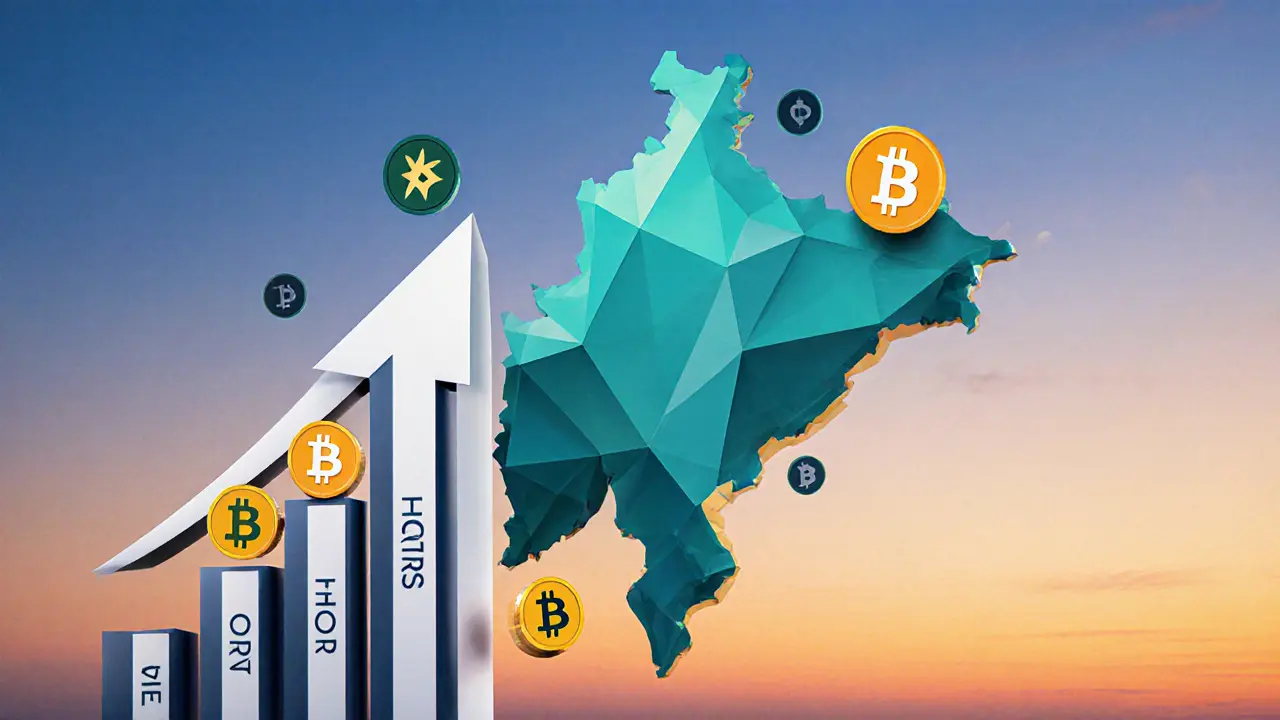Pakistan Surges to Top 4 in Global Crypto Adoption Rankings 2025

Crypto Ranking Calculator
How Ranking Methodologies Affect Results
Different crypto adoption rankings use varying methodologies. This tool simulates how Pakistan's ranking changes based on selected metrics.
Estimated Ranking
Imagine a country that once banned digital coins now sitting side‑by‑side with the United States and India in the global crypto leaderboard. Pakistan crypto adoption has vaulted into the top‑four position, and the story behind that climb is anything but ordinary.
What the rankings actually measure
Not all crypto‑adoption charts are created equal. The most cited Chainalysis a blockchain intelligence firm that publishes the Global Adoption Index each October blends four sub‑indexes: retail transaction volume, institutional inflows, usage of centralized exchanges, and activity on decentralized platforms. Each metric is adjusted for purchasing‑power parity, which levels the playing field for emerging economies.
Other ranking systems lean on ownership rates, the number of wallet addresses, or raw transaction counts without any economic weighting. That methodological split explains why Pakistan can appear at 3rd place in one list and 9th in another.
Pakistan’s 2025 Chainalysis ranking: 3rd place
The October 2025 edition of the Chainalysis Global Adoption Index shows Pakistan a South Asian nation of 230million people climbing six slots from its 2024 position to land squarely at number three, behind only India and the United States.
Key data points:
- ~20million citizens hold crypto assets worth $20‑25billion.
- Transaction volume from retail users grew by 42% YoY in 2024‑25.
- Stablecoin transfers for remittances accounted for roughly 38% of all on‑chain value.
These figures beat the global average ownership rate of 6.9% and highlight a genuine utility‑driven surge rather than a speculative bubble.
How Pakistan compares across other rankings
| Ranking source | Pakistan position | Methodology focus |
|---|---|---|
| Chainalysis Global Adoption Index | 3rd | Transaction volume + PPP adjustment |
| CryptoOwnership Survey (May2025) | 9th | Wallet address count |
| Emerging Market Crypto Index | 4th | Institutional inflows |
| Stablecoin Usage Report | 2nd | Stablecoin transfer volume |
The variation underscores why readers should scrutinise the underlying metrics before drawing conclusions.

Why the surge? The utility drivers
Three forces have powered Pakistan’s rapid climb:
- Stablecoins cryptocurrencies pegged to fiat currencies are increasingly used for cross‑border remittances, cutting fees for overseas workers sending money home.
- Hyper‑inflation has turned crypto into a hedge for savings, especially among middle‑class families who fear the devaluation of the rupee.
- Decentralized finance (DeFi) apps are filling gaps in credit access, letting small merchants earn interest on idle crypto holdings.
Chainalysis chief economist Kim Grauer who leads macro‑analysis at the firm summed it up: “Crypto adoption in Pakistan is driven by practical needs-remittances, savings protection, and local financial services-rather than pure speculation.”
The regulatory turnaround
Just seven years earlier, the State Bank of Pakistan declared digital assets illegal. In 2024‑25 the policy climate flipped:
- July2025 saw the creation of the Pakistan Virtual Assets Regulatory Authority the official body overseeing crypto compliance, offering licensing pathways for exchanges.
- The Pakistan Crypto Council an industry‑government advisory board was launched the same month, chaired by CEO Bin Saqib a fintech entrepreneur leading the council.
- Regulatory clarity has attracted both local fintech startups and foreign investors seeking a foothold in South Asia.
These institutions provide the legal scaffolding that makes large‑scale crypto activity feasible and compliant.
Key players and international partnerships
High‑profile meetings in 2025 linked Pakistan’s crypto push to global capital:
- Finance Minister Muhammad Aurangzeb co‑hosted a roundtable with Bitcoin champion Michael Saylor CEO of MicroStrategy to discuss sovereign Bitcoin reserves.
- The World Liberty Financial a US‑based fund led by Zach Witkoff signed an August2025 agreement to fund blockchain pilots across Pakistani universities.
These alliances bring expertise and capital, but they also introduce geopolitical considerations-especially given the firm’s ties to the Trump family and ongoing US‑Pakistan diplomatic negotiations.

What the numbers say about the future
Global crypto adoption grew 172% in 2024, and the trend is steady. Projections from industry analysts suggest:
- By 2030, Bitcoin users could top 1.1billion worldwide.
- Pakistan’s share of new users may remain proportionally high if stablecoin usage and regulatory support continue.
- Potential risks include over‑reliance on foreign partners and sudden policy reversals.
Overall, the combination of a large, youthful population, clear regulations, and real‑world utility points to Pakistan staying inside the global top‑10 for the foreseeable future.
Quick checklist to understand crypto‑adoption rankings
- Identify the ranking’s core metric (transaction volume, wallet count, PPP‑adjusted value, etc.).
- Check the data window-some reports use a 12‑month lag, others a rolling quarterly snapshot.
- Look for regional biases; Asian markets often dominate volume‑based indexes.
- Consider the regulatory environment-countries with clear rules usually score higher in institutional‑inflow categories.
Frequently Asked Questions
Why does Pakistan appear at different positions in various crypto adoption rankings?
Each ranking uses a distinct methodology-some weight transaction volume and purchasing‑power parity, while others count wallet addresses or focus on stablecoin flows. Those methodological differences cause Pakistan to rank anywhere from 3rd to 9th.
What role do stablecoins play in Pakistan’s crypto boom?
Stablecoins provide a low‑cost, fast way for overseas workers to send remittances and for locals to preserve value amid inflation. Their on‑chain volume accounts for roughly a third of Pakistan’s total crypto transaction value.
How has regulation changed in Pakistan since 2018?
The State Bank banned digital currencies in 2018. In 2024‑25 the government formed the Pakistan Virtual Assets Regulatory Authority and the Pakistan Crypto Council, issuing licenses for exchanges and drafting AML/KYC standards.
Is Pakistan’s crypto adoption driven mainly by speculation?
Experts like Chainalysis chief economist Kim Grauer argue the growth is utility‑focused-remittances, savings protection, and access to DeFi-rather than a speculative bubble.
What are the key risks for Pakistan’s crypto future?
Potential risks include policy flip‑flops, over‑dependence on foreign investors, and geopolitical tensions that could lead to regulatory clamp‑downs.

Mandy Hawks
October 16, 2025 AT 08:20Seeing Pakistan leap to the top‑four feels like watching a philosophy class finally get its “aha” moment – the data reveal a shift from fear to pragmatic adoption. The stablecoin surge, inflation hedging, and regulatory clarity together create a narrative that transcends pure speculation.
Scott G
October 18, 2025 AT 17:06While the statistics are compelling, it is essential to acknowledge the role of monetary policy in shaping user behavior. The correlation between inflation rates and crypto holdings warrants further scholarly examination.
VEL MURUGAN
October 21, 2025 AT 02:03The Chainalysis methodology, which adjusts for purchasing power parity, inevitably privileges economies with large, under‑banked populations. Pakistan’s 20 million wallet holders represent a significant proportion of its GDP, and the 42 % YoY transaction growth is statistically consistent with a remittance‑driven demand curve. Moreover, stablecoin volume accounting for 38 % of on‑chain value underscores a structural utility rather than speculative churn. These figures align closely with the observed institutional inflow metrics in the Emerging Market Crypto Index.
Russel Sayson
October 23, 2025 AT 11:00Pakistan’s rapid climb in the crypto adoption rankings is not a fluke; it is the result of a confluence of macro‑economic pressures and targeted policy reforms. First, the chronic devaluation of the rupee has forced households to seek alternatives that preserve purchasing power, and crypto offers a digital store of value that is not tethered to domestic inflation. Second, the diaspora, which sends over $8 billion annually, has embraced stablecoins as a low‑cost conduit for remittances, shaving off the hefty fees imposed by traditional money‑transfer operators. Third, the emergence of DeFi platforms has enabled small merchants to earn yields on idle crypto, effectively democratizing access to financial services that were previously the preserve of banks. Fourth, the establishment of the Pakistan Virtual Assets Regulatory Authority in July 2025 provided a legal sandbox that attracted both local fintech startups and foreign venture capital, creating a virtuous cycle of innovation and investment. Fifth, the Pakistan Crypto Council, chaired by industry veterans, has facilitated public‑private dialogue that translates regulatory frameworks into actionable guidelines for exchanges. Sixth, partnerships with global players such as MicroStrategy and World Liberty Financial have injected expertise and capital, accelerating infrastructure development. Seventh, the educational push through university pilots has cultivated a new generation of developers versed in blockchain technology. Eighth, the alignment of stablecoin usage with official remittance corridors has garnered support from the State Bank, which now monitors transaction flows for AML compliance. Ninth, the consistent upward trajectory in transaction volume-up 42 % YoY-demonstrates sustained user engagement beyond hype cycles. Tenth, the PPP‑adjusted metrics employed by Chainalysis inherently reward economies where crypto fulfills genuine utility gaps, placing Pakistan ahead of many larger nations. Eleventh, the relatively low barriers to entry for crypto wallets in Pakistan have enabled a broad cross‑section of the population, from urban professionals to rural farmers, to participate. Twelfth, the cultural willingness to adopt mobile money solutions paved the way for seamless integration of crypto apps into daily life. Thirteenth, the government’s willingness to license exchanges has reduced illicit activity concerns, fostering consumer confidence. Fourteenth, the media narrative has shifted from demonizing crypto to highlighting its role in financial inclusion, further normalizing its use. Finally, the combination of these factors suggests that Pakistan’s position in the top‑four is likely to be durable, provided that policymakers maintain a balanced regulatory stance.
Michael Grima
October 25, 2025 AT 19:56Yeah, looks like they finally stopped pretending crypto is dead.
Isabelle Graf
October 28, 2025 AT 03:53It’s disheartening to see countries chase hype instead of real economic reforms. Pakistan’s surge should be a wake‑up call for others.
Shane Lunan
October 30, 2025 AT 12:50Cool move by Pakistan, hope they keep the rules clear.
Jordan Collins
November 1, 2025 AT 21:46The data presented clearly illustrate a shift in user behavior driven by economic necessity rather than speculative appetite. Stablecoin adoption for remittances reduces transaction costs dramatically, which is a tangible benefit. Moreover, the regulatory clarity established in 2025 provides a framework that can sustain long‑term growth. Observers should monitor how institutional inflows evolve as the market matures.
Andrew Mc Adam
November 4, 2025 AT 06:43Yo, the whole crypto scene in Pakistan is like a wild hackathon where everyone’s sprinting to build the next DeFi bridge. The stablecoin lanes are getting flooded, and the regulators are finally playing nice, which is a major power‑up. If they keep this vibe, we might see a full stack of financial products emerging, from on‑ramps to yield farms. It’s a wild ride, but the community’s energy is real, and that’s the secret sauce.
Shrey Mishra
November 6, 2025 AT 15:40From a macro‑economic perspective, the inflationary pressure creates a compelling incentive structure for crypto adoption. The diaspora’s usage of stablecoins effectively bypasses traditional correspondent banks, reducing friction. This dual‑force dynamic accelerates both retail and institutional participation.
Ken Lumberg
November 9, 2025 AT 00:36We cannot ignore the geopolitical implications of a nation like Pakistan leveraging crypto for financial sovereignty. The partnership with US‑based funds raises eyebrows about external influence. Still, the economic benefits to the local populace are undeniable.
Marques Validus
November 11, 2025 AT 09:33Wow this is insane the crypto wave hitting Pakistan is like a full‑blown bull run on steroids DeFi is exploding wallets are popping everywhere and the regulators are finally saying “go ahead” it’s a perfect storm of tech finance and policy the market is about to explode
Michael Bagryantsev
November 13, 2025 AT 18:30Sharing these insights can help newcomers navigate the evolving landscape. It’s important to stay grounded while exploring opportunities.
Maria Rita
November 16, 2025 AT 03:26What an inspiring story of resilience and innovation! Pakistan’s journey shows that challenges can become catalysts for growth. Keep cheering on the community!
Jordann Vierii
November 18, 2025 AT 12:23By embracing crypto, Pakistan is joining a global movement toward digital inclusion. This cultural shift could inspire neighboring regions.
Lesley DeBow
November 20, 2025 AT 21:20One could argue that technology mirrors society’s deepest aspirations – a pursuit of freedom and efficiency 😊
DeAnna Greenhaw
November 23, 2025 AT 06:16The ascendancy of Pakistan within the crypto adoption hierarchy warrants a rigorous analytical discourse. It is incumbent upon scholars to dissect the multivariate determinants underpinning this phenomenon. Moreover, the juxtaposition of methodological frameworks across ranking entities underscores the necessity for epistemological clarity. Consequently, future inquiries should prioritize longitudinal assessments to elucidate sustainability trajectories.
Luke L
November 25, 2025 AT 15:13Let’s be honest the West can’t afford to lose a strategic foothold in South Asia and Pakistan’s crypto boom is a clear signal. Any policy that hampers this momentum is nothing short of betrayal. We must stand firm in defending this progress.